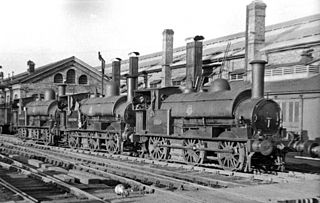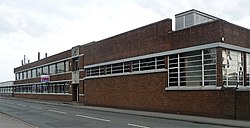
The railway system in Great Britain is the oldest railway system in the world. The first locomotive-hauled public railway opened in 1825, which was followed by an era of rapid expansion. Most of the track is managed by Network Rail, which in 2017 had a network of 15,811 kilometres (9,824 mi) of standard-gauge lines, of which 5,374 kilometres (3,339 mi) were electrified. These lines range from single to quadruple track or more. In addition, some cities have separate metro, light rail and tram systems. There are also many private railways, which are primarily short lines for tourists. The main rail network is connected with that of continental Europe by the Channel Tunnel and High Speed 1, which fully opened in 1994 and 2007 respectively.
British Railways (BR), which from 1965 traded as British Rail, was a state-owned company that operated most of the overground rail transport in Great Britain from 1948 to 1997. It was formed from the nationalisation of the Big Four British railway companies, and was privatised in stages between 1994 and 1997. Originally a trading brand of the Railway Executive of the British Transport Commission, it became an independent statutory corporation in January 1963, when it was formally renamed the British Railways Board.

A locomotive or engine is a rail transport vehicle that provides the motive power for a train. If a locomotive is capable of carrying a payload, it is usually rather referred to as a multiple unit, motor coach, railcar or power car; the use of these self-propelled vehicles is increasingly common for passenger trains, but rare for freight.

A train is a series of connected vehicles that run along a railway track and transport people or freight. Trains are typically pulled or pushed by locomotives, though some are self-propelled, such as multiple units. Passengers and cargo are carried in railroad cars, also known as wagons. Trains are designed to a certain gauge, or distance between rails. Most trains operate on steel tracks with steel wheels, the low friction of which makes them more efficient than other forms of transport.

The London and North Western Railway was a British railway company between 1846 and 1922. In the late 19th century, the L&NWR was the largest joint stock company in the United Kingdom.

The London, Midland and Scottish Railway (LMS) was a British railway company. It was formed on 1 January 1923 under the Railways Act of 1921, which required the grouping of over 120 separate railways into four. The companies merged into the LMS included the London and North Western Railway, Midland Railway, the Lancashire and Yorkshire Railway, several Scottish railway companies, and numerous other, smaller ventures.

The history of rail transport began in the BCE times. It can be divided into several discrete periods defined by the principal means of track material and motive power used.
Charles Edward Fairburn was an English electrical engineer whose work mainly concerned rail transport.
British Rail reserved the TOPS Class 97 designation for departmental locomotives, which were used for special or engineering duties. They were therefore of several different classes, lumped together for numbering purposes. Some locomotives were converted from redundant engines, whilst others were purpose built. In 2008, Network Rail once again used Class 97 for signalling test locomotives.

The British Rail Class 159 is a class of British diesel multiple unit passenger trains of the Sprinter family, built in 1989–1992 by British Rail Engineering Limited (BREL)'s Derby Litchurch Lane Works as Class 158. Before entering traffic, the original 22 units were modified at Rosyth Dockyard to Class 159 to operate services from London Waterloo to Salisbury and Exeter St Davids, replacing various locomotive-hauled passenger trains.

The Swanage Railway is a railway branch line from near Wareham, Dorset to Swanage, Dorset, England, opened in 1885 and now operated as a heritage railway.

The Derby Works comprised a number of British manufacturing facilities designing and building locomotives and rolling stock in Derby, England. The first of these was a group of three maintenance sheds opened around 1840 behind Derby station. This developed into a manufacturing facility called the Midland Railway Locomotive Works, known locally as "the loco" and in 1873 manufacturing was split into locomotive and rolling stock manufacture, with rolling stock work transferred to a new facility, Derby Carriage & Wagon Works.

The Victorian Railways (VR), trading from 1974 as VicRail, was the state-owned operator of most rail transport in the Australian state of Victoria from 1859 to 1983. The first railways in Victoria were private companies, but when these companies failed or defaulted, the Victorian Railways was established to take over their operations. Most of the lines operated by the Victorian Railways were of 5 ft 3 in. However, the railways also operated up to five 2 ft 6 in narrow gauge lines between 1898 and 1962, and a 4 ft 8+1⁄2 instandard gauge line between Albury and Melbourne from 1961.

The British Rail Class 43 (HST) is the TOPS classification used for the InterCity 125 High Speed Train (formerly Classes 253 and 254) power cars, built by British Rail Engineering Limited from 1975 to 1982, and in service in the UK since 1976.

The Railway Technical Centre (RTC) in London Road, Derby, England, was the technical headquarters of the British Railways Board, and was built in the early 1960s. British Rail described it as the largest railway research complex in the world.

The British Rail Research Division was established in 1964 directly under the control of the British Railways Board, moving into purpose-built premises at the Railway Technical Centre in Derby. The intention was to improve railway reliability and efficiency, while reducing costs and improving revenue. In so doing it became recognised as a centre of excellence and, in time, was providing consultancy to other railways around the world. While it became famous for the Advanced Passenger Train (APT), its activities extended into every area of railway operation. The theoretical rigour of its approach to railway engineering superseded the ad hoc methods that had prevailed previously.

Wolverton railway works, known locally as Wolverton Works or just The Works, was established in Wolverton, Buckinghamshire, by the London and Birmingham Railway Company in 1838 at the midpoint of the 112-mile-long (180-kilometre) route from London to Birmingham. The line was developed by Robert Stephenson following the great success of the Liverpool and Manchester Railway line.

Crewe Works is a British railway engineering facility located in the town of Crewe, Cheshire. The works, which was originally opened by the Grand Junction Railway in 1840, employed around 7,000 to 8,000 workers at its peak. In the 1980s much of the engineering works were closed. Most of the site has been redeveloped, but the remaining parts are owned and operated by Alstom.

The InterCity 250 was an electric railway project undertaken by British Rail in the late 1980s. The InterCity 250 train would have consisted of a Class 93 electric locomotive, nine Mark 5 coaches and a Mark 5 Driving Van Trailer operating in a push-pull formation. The British Rail project was cancelled in July 1992.

The LMS School of Transport was built between 1937 and 1938 by the London, Midland and Scottish Railway in Derby, Derbyshire and is now a Grade II listed building used as the Derby Conference Centre.


















